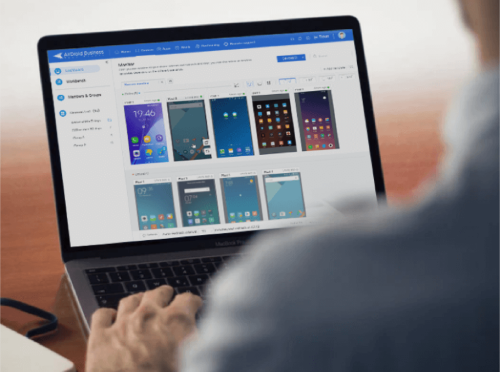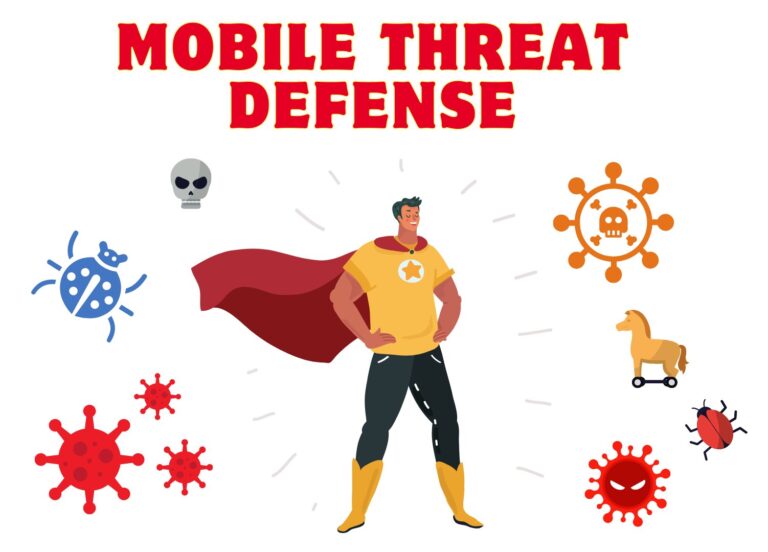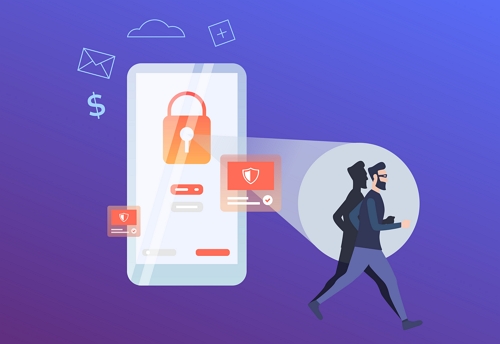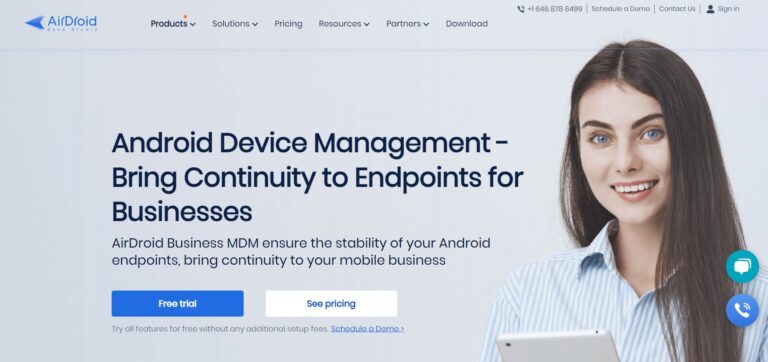Mobile Threat Defense (MTD): A Shield against Device Threats
Part 1. Mobile threat defense (MTD) explained
Mobility, flexibility, and accessibility are king in today’s business environment. The rise in mobile devices being used for business has risen sharply, increasing the need for employers to implement enhanced and robust security measures across their fleet of mobile devices.
Employees are more frequently displaced from the traditional office setting, accessing business-critical information from disparate geographical locations, with myriad apps, platforms, and networks being used.

It’s not hyperbole to suggest that one compromised device could have significantly negative consequences for a whole organisation. To combat this, Mobile Threat Defense is paving the way as the best all-around tool to safeguard against cybersecurity threats.
In this post, we’ll talk about how it works, common threats, MTD benefits, essential features to look for in mobile threat management, its challenges and limitations, and how Mobile Device Management (MDM) complements MTD in mobile security.

Datasheet for Mobile Device Management (MDM)
If you are looking for a better solution to secure company-owned mobile devices, you’ll want to grab our Datasheet for MDM. It’s loaded with detailed information to help you make the best decision for your organization's needs.
Part 2. How does MTD work?
Mobile threat defense (commonly referred to as MTD) does exactly what it says on the tin. It’s a comprehensive security solution designed with sole purpose to detect and respond threats to your mobile devices, networks, apps and platforms.

It does this by continuously monitoring the behaviour of mobile devices, analysing network traffic, app activities, and system processes in real-time, checking for vulnerabilities, anomalies, misconfigurations, and more.
There are constantly evolving threats to be aware of in the modern digital age that could do irreparable damage to an unprepared and unguarded organisation. A good MTD tool can not only make you aware of them but protect you against them with defensive and offensive tactics.
But first, let’s look at some of the threats.
Part 3. Common device threats for businesses
The most common threats businesses should know about are:
• Malware
The sole purpose of malware is to infiltrate and infect mobile devices and is often seen in forms like ransomware, spyware, Trojan horses and adware. It’s used to steal sensitive information like passwords, contact information, banking information and more.
• Malicious apps
Sometimes apps seem legitimate but are anything but. These apps will contain hidden malicious code, which leaves devices primed for cyber-criminals to steal data or seize control of devices entirely.
• Phishing
Phishing is a common technique used by malicious actors – this social engineering attack tricks users into revealing sensitive information like passwords or credit card details, typically through emails designed to look legitimate.

• System vulnerabilities
Security weaknesses within mobile operating systems, such as misconfigured settings, leave devices exposed and more susceptible to attacks.
• Man-in-the-Middle Attacks
A type of attack where a bad actor intercepts communication between two parties on a compromised network or channel – think unsecure WiFi networks in public spaces – attackers can then eavesdrop, modify, or steal sensitive data.
Mobile threat management can help shield against all these very real threats, offering a number of benefits in the process.

Part 4. Benefits of mobile threat defense solutions
We wouldn’t be here if there weren’t some huge benefits to mobile threat management. The primary ones include:
- Enhanced security: The obvious but important one is that MTD strengthens security for your device fleet, providing mobile threat protection against a wide range of menances.
- Real-time threat detection: An effective MTD solution continuously monitors all device activity, meaning threats are detected as they emerge, which is critical for mitigating any damage by responding immediately.
- Reduced risk of data breaches: By proactively identifying and dealing with threats, data breaches – and the associated subsequent reputational and financial damages – are prevented.
- Compliance: Mobile threat defense software will often come with features that allow you to create and implement compliance policies and actions, giving managers much-needed governance. For instance, they can help to ensure HIPAA compliance in the healthcare sector.
- Peace of mind: Feeling confident and assured that your fleet of devices are being protected by a sophisticated and robust tool may be the biggest benefit there is.
So, what can you expect from an everyday MTD tool?
Part 5. Features to look out for in mobile threat defense software
While many MTD tools share common features, these are the important ones to consider when procuring one for your organisation:
Real-time monitoring and alerts
The ability to monitor device activities in real-time, ensuring that threats are detected immediately.
Network security
A good MTD tool will encrypt devices, whichever network they connect to, protecting those endpoints from being exposed to rogue access points.
Machine learning and AI
Advanced machine learning algorithms and AI will offer continuously refined insights and reports to identify evolving threats, which can optimise decision-making and policy implementation.

Threat intelligence
Access to up-to-date information on emerging threats, through feeds from authorised and trusted sources.
Multi-platform support
With myriad mobile devices and operating systems to manage, compatibility across all of them is crucial.
Health checks
Perform regular health checks on endpoints to determine if they meet security standards or if remedial measures are necessary.
Customisable policies
Create and implement conditional policies to provide secure access to certain apps, networks or other resources.
There are evidently numerous benefits and features, but what about disadvantages?
Part 6. Challenges and limitations of MTD
It’s important to note that MTD tools aren’t a panacea that guarantees infallible protection against any and all threats an organisation may face, but the right solution will still have dramatic benefits.
With that said, there are some challenges and limitations that organisations should understand:
Limitations
- False positives: Mobile threat defense software may occasionally flag legitimate apps or behaviours as threats, leading to false alarms.
- Device compatibility: It may be challenging to ensure compatibility with the wide range of devices and operating systems likely to be within the device fleet.
- Evolving threats: While MTD tools are always evolving, so are cyber threats. MTD solutions simply have to keep pace to remain an effective tool.
Part 7. How MDM complements MTD in mobile security
MTD solutions work best when integrated within a mobile device management platform.
Mobile Device Management has it in the name: it simply manages the fleet of devices by giving organisations the ability to enforce policies, remotely wipe devices, and manage applications.
Meanwhile, MTD carries out protective measures that MDM solutions typically cannot, such as detecting malicious apps, in real-time. Both act as a comprehensive and symbiotic solution that maximises your mobile threat protection against cyberthreats.
Part 8. AirDroid Business MDM
We hope that by now you’ve got a solid understanding of how an effective mobile threat defense software, integrated into an effective MDM solution, can have far-reaching benefits for your business.
AirDroid Business MDM is one such that offers a comprehensive suite of features exclusively designed to protect your mobile devices and keep your data secure.

Some of the game-changing tools include:
1. Policy enforcement:
Ensure that devices adhere to security policies, including security authentication requirements, device compliance, and data loss prevention measures.
2. Kiosk Mode:
Create a fully customised environment with restricted access to a specific app or group of apps, websites, and device functionalities.
3. Application management:
Configure, deploy and manage business apps over-the-air with rich rollout options – all from a single remote dashboard.
4. Monitor and alerts:
Remote monitor, receive alerts, and respond to abnormal events for endpoints (e.g. excessive data usage or network errors) in real time.
5. Advanced encryption:
Secure file transfer with multi-layered encryption using HTTPS and end-to-end encryption.
Part 9. Final thoughts
There has never been a greater need for mobile threat protection against digital security risks than today. And that need will only increase. That’s because mobile devices for work will continue to grow, while threats evolve.
A sophisticated Mobile Threat Defense (MTD) solution, combined with a great Mobile Device Management (MDM) tool, is the best way for organisations to shore up their defenses against bad actors and malicious threats.






Leave a Reply.